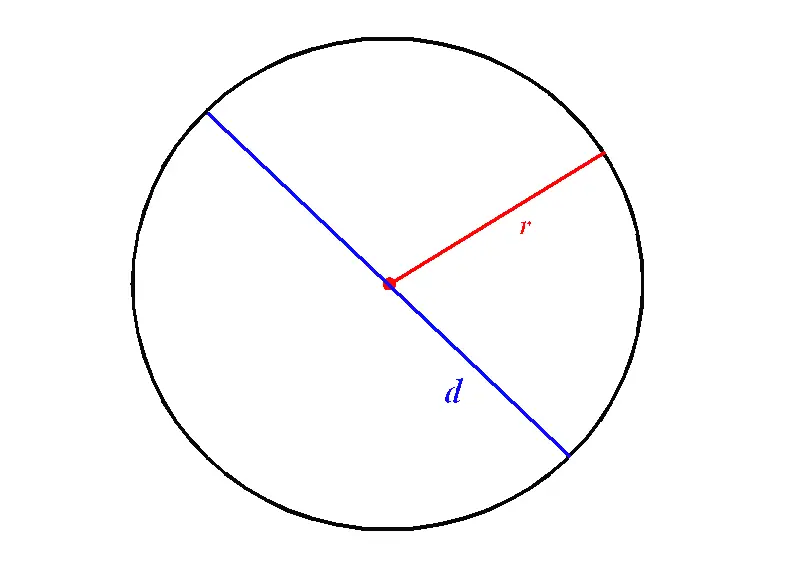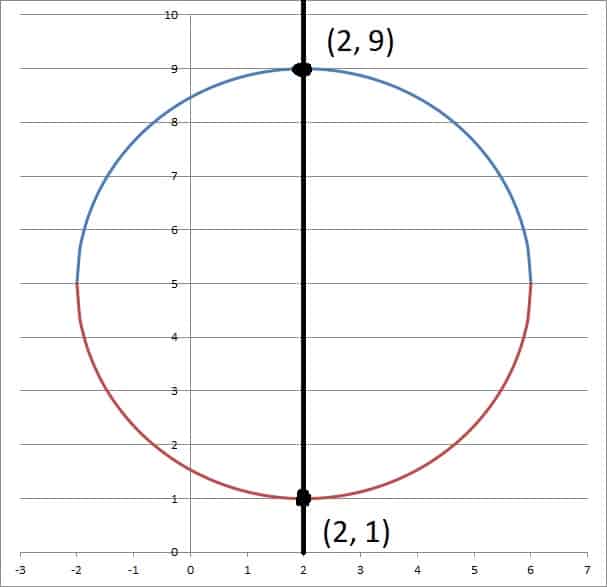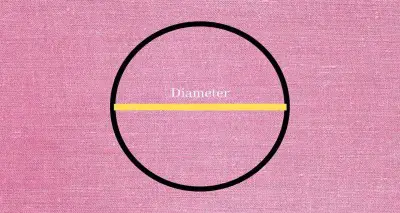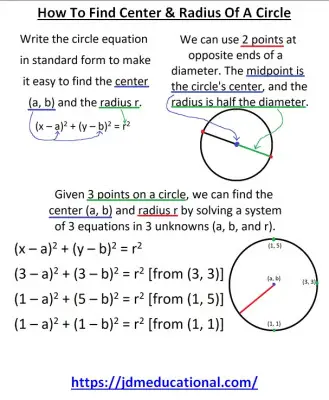Circles are used throughout mathematics and in everyday life. However, knowing how to find the center or radius from other given information might also be useful.
So, how do you find the center & radius of a circle? To find the center & radius of a circle, put the circle equation in standard form. We can also use three points on a circle (or two points if they are at opposite ends of a diameter) to find the center and radius. In addition, we can use the center and one point on the circle to find the radius.
Of course, it helps to be familiar with the standard form of a circle equation so that you can easily work with these various situations.
In this article, we’ll talk about how to find the center and radius of a circle given information about it (such as its equation or points on the circle). We’ll also go through some examples to make the concepts clear.
Let’s get started.
How To Find The Center & Radius Of A Circle
The way that we find the center & radius of a circle depends on the information we are given:
- From An Equation: with an equation in standard form, we can find the center and radius of the circle easily. Otherwise, we will need to complete the square for the x or y variable (or both) to convert to standard form.
- With Two Points: given two points on the circle at opposite ends of a diameter, we can find the center. We can also find the radius given the center and a single point on the circle by using the distance formula.
- With Three Points: given three points on the circle, we can find the center and radius of the circle by solving a system of three equations in three unknowns (a, b, and r).

Let’s start with finding the center of a circle from a given equation.
Find The Center Of A Circle From An Equation
To find the center of a circle from an equation, we always want to convert to standard form.
Remember that the equation of a circle in standard form is given by:
- (x – a)2 + (y – b)2 = r2
where (a, b) is the center of the circle and r is the radius of the circle.
If we are given an equation that is not in standard form, we will need to complete the square for one or both variables (x and y) first.
Example 1: Center Of A Circle From An Equation In Standard Form
Let’s say we want to find the center of the circle given by the equation
- (x – 2)2 + (y + 4)2 = 9
Comparing this to the standard form above, we can see that a = 2 and b = -4 (watch out for those negative signs: y – (-4) is the same as y + 4).
So, the center of the circle is (a, b) = (2, -4).
Example 2: Center Of A Circle From An Equation By Completing The Square For One Variable
Let’s say we want to find the center of the circle given by the equation
- x2 + y2 + 6x + 10y + 25 = 27
This circle is not in standard form, so we know we will need to complete the square for at least one variable.
After rearranging the terms so the variables are grouped together, we get:
- (x2 + 6x) + (y2 + 10y + 25) = 27
It is easy to see that the expression with the y variable, y2 + 10y + 25, factors as a perfect square trinomial, (y + 5)2:
- (x2 + 6x) + (y + 5)2 = 27
Now we just need to complete the square for the expression with the x variable, x2 + 6x. Remember that to complete the square, we take half of the x coefficient and square the result, then add it to both sides.
Here, the x-coefficient is 6, so half of that gives us a result of 3. Squaring the result gives us 32 = 9.
So, we add 9 to both sides of the equation to get:
- (x2 + 6x + 9) + (y + 5)2 = 27 + 9
Note that we grouped the +9 on the left with the x terms. This allows us to factor as another perfect square trinomial:
- (x + 3)2 + (y + 5)2 = 36
Now, we have the circle equation in standard form. Comparing it to the general equation listed above, we find that a = -3 and b = -5.
So, the center of the circle is (a, b) = (-3, -5).
Example 3: Center Of A Circle From An Equation By Completing The Square For Two Variables
Let’s say we want to find the center of the circle given by the equation
- x2 + y2 + 8x + 12y = 12
This circle is not in standard form, so we know we will need to complete the square for both variables.
After rearranging the terms so the variables are grouped together, we get:
- (x2 + 8x) + (y2 + 12y) = 12
First, we need to complete the square for the expression with the x variable, x2 + 8x. Remember that to complete the square, we take half of the x coefficient and square the result, then add it to both sides.
Here, the x-coefficient is 8, so half of that gives us a result of 4. Squaring the result gives us 42 = 16.
So, we add 16 to both sides of the equation to get:
- (x2 + 8x + 16) + (y2 + 12y) = 12 + 16
Note that we grouped the +12 on the left with the x terms. This allows us to factor as a perfect square trinomial:
- (x + 4)2 + (y2 + 12y) = 28
Now, we need to complete the square for the expression with the y variable, y2 + 12y. Remember that to complete the square, we take half of the x coefficient and square the result, then add it to both sides.
Here, the x-coefficient is 12, so half of that gives us a result of 6. Squaring the result gives us 62 = 36.
So, we add 36 to both sides of the equation to get:
- (x2 + 8x + 16) + (y2 + 12y + 36) = 28 + 36
Note that we grouped the +36 on the left with the y terms. This allows us to factor as a perfect square trinomial:
- (x + 4)2 + (y + 6)2 = 64
Now, we have the circle equation in standard form. Comparing it to the general equation listed above, we find that a = -4 and b = -6.
So, the center of the circle is (a, b) = (-4, -6).
Find The Center Of A Circle With Two Points (At Endpoints Of A Diameter)
Given two points on a circle, we may be able to find the center. If they do not lie on the same diameter, then we don’t have enough information, and we can only specify an entire family of circles, rather than one specific circle.
However, given two points on a circle that lie at the endpoints of a diameter, we can find the center of the circle.

All we need to do is find the midpoint of the line segment between the two points on the diameter.
Remember that for a line segment with endpoints (x1, y1) and (x2, y2), the midpoint formula is given by:
- (xm, ym) = ((x1 + x2) / 2, (y1 + y2) / 2)
Essentially, xm is the average of the x coordinates of the endpoints, and ym is the average of the y coordinates of the endpoints.
Let’s try an example to see how it works.
Example: Find The Center Of A Circle With Two Points On A Diameter
Let’s say we want to find the center of the circle with points (0, 0) and (6, -8) as endpoints of a diameter.
Using the midpoint formula to find the center of the circle gives us:
- (xm, ym) = ((x1 + x2) / 2, (y1 + y2) / 2)
- (xm, ym) = ((0 + 6) / 2, (0 + -8) / 2)
- (xm, ym) = (6 / 2, -8/ 2)
- (xm, ym) = (3, -4)
So the center of this circle is at (3, -4).
We can also find the radius of the circle if we wish. It is simply half of the diameter, which is given by the distance formula:
- D = √((x2 – x1)2 + (y2 – y1)2)
- D = √((6 – 0)2 + (-8 – 0)2)
- D = √((6)2 + (-8)2)
- D = √(36 + 64)
- D = √(100)
- D = 10
So the diameter is 10, and the radius is 5.

Find The Center Of A Circle From Three Points
To find the center of a circle from three points, we can simply substitute the x and y values from each point into the circle equation.
Then, we can set all 3 equations equal to each other (they all equal r2, or the radius squared).
Then, we can write separate equations, simplify them, and solve simultaneous linear equations.
Let’s look at an example.
Example: Find The Center Of A Circle From Three Points
Let’s say we are given the points (-1, -3), (-2, 4), and (5, 5) on a circle.
We will plug each of these points, in turn, into the standard form of a circle:
- (x – a)2 + (y – b)2 = r2
For the first point (-1, -3), we get:
- (-1 – a)2 + (-3 – b)2 = r2
For the second point (-2, 4), we get:
- (-2 – a)2 + (4 – b)2 = r2
For the third point (5, 5), we get:
- (5 – a)2 + (5 – b)2 = r2
We can set any two of the left sides equal to each other, since the right sides are all r2 (regardless of the value of r).
Setting the first two left sides equal gives us:
- (-1 – a)2 + (-3 – b)2 = (-2 – a)2 + (4 – b)2
- 1 + 2a + a2 + 9 + 6b + b2 = 4 + 4a + a2 + 16 – 8b + b2
- 1 + 2a + a2 + 9 + 6b = 4 + 4a + a2 + 16 – 8b [subtract b2 from both sides]
- 1 + 2a + 9 + 6b = 4 + 4a + 16 – 8b [subtract a2 from both sides]
- 10 + 2a + 6b = 20 + 4a – 8b [combine constant terms on both sides]
- -10 – 2a + 14b = 0 [collect all terms on one side and combine like terms]
- 5 + a – 7b = 0 [divide by -2 on both sides]
Setting the first and third left sides equal gives us:
- (-1 – a)2 + (-3 – b)2 = (5 – a)2 + (5 – b)2
- 1 + 2a + a2 + 9 + 6b + b2 = 25 – 10a + a2 + 25 – 10b + b2
- 1 + 2a + a2 + 9 + 6b = 25 – 10a + a2 + 25 – 10b [subtract b2 from both sides]
- 1 + 2a + 9 + 6b = 25 – 10a + 25 – 10b [subtract a2 from both sides]
- 10 + 2a + 6b = 50 – 10a – 10b [combine constant terms on both sides]
- -40 + 12a + 16b = 0 [collect all terms on one side and combine like terms]
- -10 + 3a + 4b = 0 [divide by 4 on both sides]
Now we can solve the following system by elimination:
- 5 + a – 7b = 0
- -10 + 3a + 4b = 0
To do this, multiply the first equation by -3 to get:
- -15 – 3a + 21b = 0
- -10 + 3a + 4b = 0
Now add the two equations to get:
- -25 + 0a + 25b = 0
- 1 = b
So, with b = 1 , we find:
- 5 + a – 7b = 0
- 5 + a – 7(1) = 0
- 5 + a – 7 = 0
- a – 2 = 0
- a = 2
So, the center of the circle is at (a, b) = (1, 2). We can then use the center and any point on the circle to find the radius, by using the distance formula (more detail on this method below).
Find The Radius Of A Circle From An Equation
To find the radius of a circle from an equation, we always want to convert to standard form.
Remember from earlier that the equation of a circle in standard form is given by:
- (x – a)2 + (y – b)2 = r2
where (a, b) is the center of the circle and r is the radius of the circle.
If we are given an equation that is not in standard form, we will need to complete the square for one or both variables (x and y) first.
Example 1: Center Of A Circle From An Equation In Standard Form
Let’s say we want to find the radius of the circle given by the equation
- (x – 3)2 + (y + 5)2 = 49
Comparing this to the standard form above, we can see that r = 7 (since r2 = 49 – remember to take the square root to find r).
So, the radius of the circle is r = 7.
Example 2: Radius Of A Circle From An Equation By Completing The Square
Let’s say we want to find the radius of the circle given by the equation
- x2 + y2 + 8x + 12y + 12 = 24
This circle is not in standard form, so we know we will need to complete the square for at least one variable.
After rearranging the terms so the variables are grouped together, we get:
- (x2 + 8x) + (y2 + 12y) = 24 – 12
- (x2 + 8x) + (y2 + 12y) = 12
To complete the square for the x variable, x2 + 8x, we take half of 8 to get 4, and square this result to get 16. We add 16 to both sides:
- (x2 + 8x + 16) + (y2 + 12y) = 12 + 16
- (x2 + 8x + 16) + (y2 + 12y) = 28
Now we need to factor the x expression, x2 + 8x + 16. It is a perfect square binomial: (x + 4)2.
- (x + 4)2 + (y2 + 12y) = 28
To complete the square for the y variable, y2 + 12y, we take half of 12 to get 6, and square this result to get 36. We add 36 to both sides:
- (x + 4)2 + (y2 + 12y + 36) = 28 + 36
- (x + 4)2 + (y2 + 12y + 36) = 64
Now we need to factor the y expression, y2 + 12y + 36. It is a perfect square binomial: (y + 6)2.
- (x + 4)2 + (y + 6)2 = 64
- (x + 4)2 + (y + 6)2 = 82
We also rewrote 64 as 82, since this matches the r2 on the right side of a circle equation in standard form.
Now we know that the radius of the circle is r = 8.
Find The Radius Of A Circle Given Center & Point
If we know the center of a circle and one point on the circle, we can find the radius with the distance formula.
(Remember the radius is the distance between the center of the circle and any point on the circle.)
Let’s look at an example of how to do this.
Example: Finding The Radius Of A Circle Given The Center & A Point On The Circle
Let’s say that you are given the center of a circle at (4, 3) and a point on the circle at (16, 12). Using the distance formula gives us:
- D = √((x2 – x1)2 + (y2 – y1)2)
- D = √((16 – 4)2 + (12 – 3)2)
- D = √((12)2 + (9)2)
- D = √(144 + 81)
- D = √(225)
- D = 15
So, the radius of the circle is 15.
Find The Radius Of A Circle With Two Points On The Circle
In this case, we cannot solve for a single circle, since we do not have enough information. Instead, we would get an entire family of circles that contain both points.
If we also have the center or a third point on the circle, we can find the radius (by using the distance formula with the center as one point and one of the points on the circle as the other point).
We can then use the center and radius to write the equation of the circle in standard form.

Conclusion
Now you know how to find the center and radius of a circle in various situations. You also know how to use the midpoint and distance formulas as shortcuts to make your calculations a little bit easier.
You can learn about the circumference and area of a circle in my article here.
You can learn about arc length of a circle here.
You can learn about area of a circular sector here.
You can learn how to find the perimeter and area of circular sectors (parts of a circle) in my article here.
You might also want to read my article on common questions about ellipses (a circle is just a specific type of ellipse).
To learn about applications of circles, check out my article on how circles are used.
You can find out more about squares and circles here.
I hope you found this article helpful. If so, please share it with someone who can use the information.
Don’t forget to subscribe to my YouTube channel & get updates on new math videos!
~Jonathon



